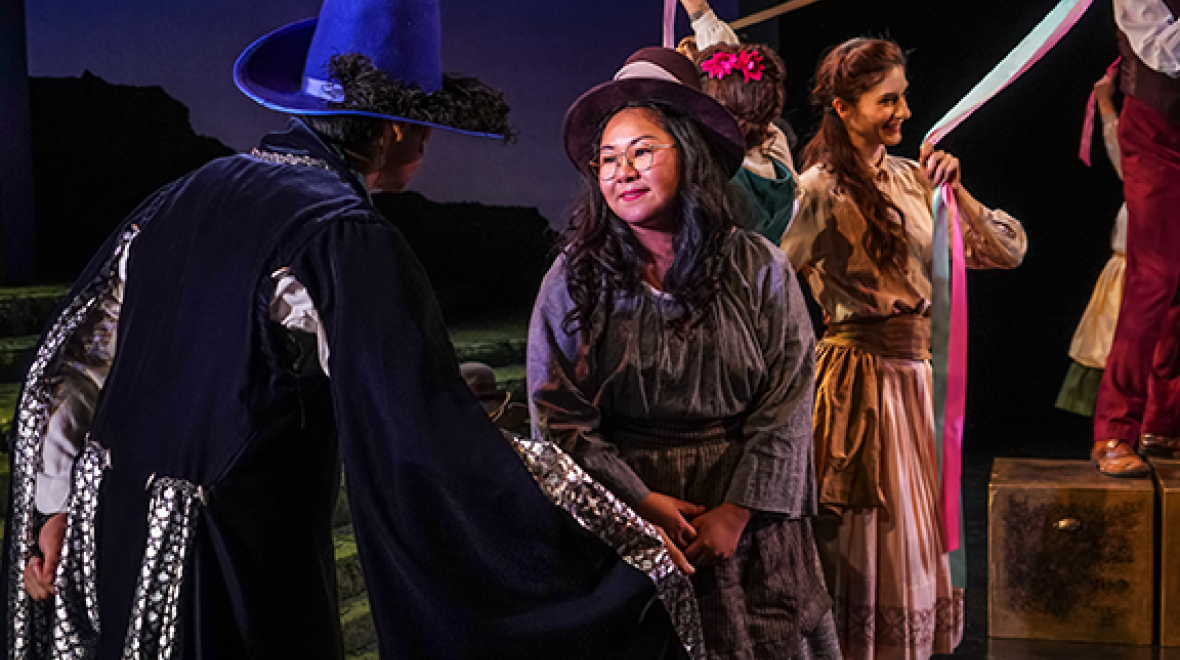
Photo:
Sara Porkalob (Sophie Hatter) in Book-It's latest production. Photo by Alabastro Photography.
"Howl’s Moving Castle" is ambitious. Book-It Repertory Theatre’s first full-scale musical adapts a wry children’s fantasy novel by Diana Wynne Jones that has already been made into a beloved animated movie by Hayao Miyazaki.
In it, young Sophie Hatter unwittingly stumbles into the feud between Wizard Howl and the Witch of the Waste, and is cursed with old age. Taking refuge in Howl’s magical moving castle, she makes a deal to help free Howl’s fire demon. Sisters switch places, people go missing and everyone is casting spells or under a spell in subplots that come together so rapidly at the end you might need to reread the last chapters. Not only did Book-It set all this to song, but it did so through an intersectional lens.
My first experience of Seattle theater was a production of "Romeo and Juliet" that caused a stir by casting African-American actors as Romeo and Tybalt. Nearly 30 years later, race is still an issue in casting. But "Howl’s Moving Castle" proves that intersectionality makes for better theater.
For those who don't know, "Howl's Moving Castle" is based on a British book and later made into a movie by the famous Japanese animation company Studio Ghibli. In both the book and movie, there is an assumption of universal whiteness for the characters, which makes Book-It's casting all the more important.
It would be a tragedy to prioritize skin tone and deprive the world of Sara Porkalob’s Sophie. Her hapless yet grounded Sophie transforms from a teen to an old woman without a gray wig or drawn-on wrinkle. She conveys nuances of age and character even while singing beautifully. I’m kicking myself for missing her show, "Dragon Lady," earlier this fall.
Another character impressed my 13-year-old. She said that seeing African-American actress Sarah Russell in the role of the prettiest sister, Lettie, exploded her image of the character. It made her wonder why she expected the “pretty one” to be a tiny blond in the first place.
Similarly, Michael Feldman is not the blue-eyed, flaxen-haired Howl described in the novel, but his honeyed baritone worked perfectly for the heartless playboy. Howl swans around looking cool (not just anyone can pull off silver pants), always the center of attention but rarely driving the story. Under the direction of adapter Myra Platt, the play gives more attention to Sophie’s family relationships than her romance with Howl — even at the end, there’s no Hollywood kiss, or even a Disney one. Sophie archly comments that “Happily ever after with you would be... interesting.”
Sophie and her sisters consistently support each other. Martha (disguised as Lettie) admonishes Sophie to pursue her dreams rather than her duties in the joyous “Cake.” The real Lettie (who happens to be the smart one as well as the pretty one, and no one hates her for it) sends her own "suitor" to guard Sophie when she believes her older sister to be Howl’s next target. Old age even gives Sophie the perspective to realize how much she has in common with her stepmother.
The real focus of the story is Sophie’s discovery of her own power. As the eldest of three, Sophie believes she is destined to fail "first and worst" according to fairy tale tradition. Though Sophie never does anything right, she somehow does a lot that no one else could do at all.
The charm of the play lies in its humor, which shifts from dry to laugh-out-loud funny, but never lets up.
But the charm of the play lies in its humor, which shifts from dry to laugh-out-loud funny, but never lets up. The irreverent tone is set in the opening song, “In Ingarry.” Sophie’s introduction would be like Belle’s “This Provincial Life” if it were not repeatedly interrupted by her sisters’ bickering. The entire cast has impeccable comedic timing that both captures Wynne Jones’ spirit and gives it a modern touch. Sophie pokes holes in Howl’s vanity without being mean-spirited, while Howl’s outbursts at Sophie’s meddling generate laughs. His transformation from elegant wizard to Welsh rugby fan is particularly entertaining. Fire demon Calcifer (Lamar Legend) is snarky and petulant, as you would expect for (spoiler!) someone fed by Howl’s heart. Endearingly naïve Michael (Randall Scott Carpenter) is perhaps the only person as clueless as Sophie, like a teenage Samwise Gamgee.
All 23 songs in Howl’s Moving Castle were written for this production by local artist Justin Huertas. I could imagine some of these songs on Broadway, but most of the time they break the Broadway formula, feeling fresher than most musical theater. When they weren’t singing, the actors were narrating, which could have gone badly. But having characters simply announce, “Sophie went to visit her sister,” or “Calcifer was bored,” was an efficient, storybook-like way to keep up the pace of a dense plot.
"Howl" is already a favorite at my house. We’ve read all the Ingarry books and practically memorized the movie. But sometimes the most loved stories are the ones that most disappoint in adaptation, so I don’t think I’m being biased when I say that Book-It’s production is a nearly perfect adaptation of "Howl’s Moving Castle" into musical theater.
Parents should know
Based on a children’s book, there is no rude language, violence or sex. There is a lot of humor, catchy music, and strong, entertaining female characters. The only challenge for kids is the complicated plot. There’s a lot of story to fit into roughly 2.5 hours (with a 15-minute intermission). It probably helps to be familiar with the book. My 13-year-old and my 9-year-old both loved the play. The theater suggests the play is best for ages 10+, but I can unreservedly recommend "Howl’s Moving Castle" for any child who can sit still for more than an hour at a time.
Parent tips
- Book-It is located in the basement of the Armory at Seattle Center. Traffic can be heinous, so give yourself plenty of time and arrive early to enjoy Winterfest before the show
- The play follows the book more closely than the movie, but if you don’t have time to read the book first, the movie is a delightful place to familiarize your kids with the basic story and main characters. (Consider buying a copy of the book before you leave the theater. After all, inspiring audiences to read is part of Book-It’s mission.)
If you go...Where: Center Theatre at the Armory, 305 Harrison St., Seattle When: Through Dec. 30, Wed.–Sat. 7:30 p.m.; Sundays and Dec. 16, 23, 29, 30 at 2 p.m. Tickets: $26 Parking: There are many parking options near Seattle Center. All of them are expensive. Consider public transit. The Seattle Center website has information about both options. |











